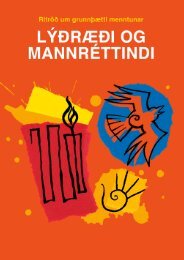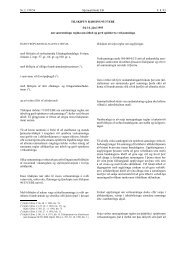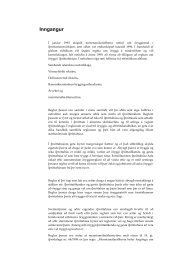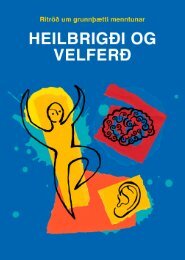Arts and Cultural Education in Iceland : Professor Anne Bamford
Arts and Cultural Education in Iceland : Professor Anne Bamford
Arts and Cultural Education in Iceland : Professor Anne Bamford
Create successful ePaper yourself
Turn your PDF publications into a flip-book with our unique Google optimized e-Paper software.
Figure 1.12.4 shows that pop <strong>and</strong> rock <strong>and</strong> world music are less likely to be taught than<br />
classical <strong>and</strong> jazz music. Over 80% of respondents felt that western classical music is essential or<br />
‘matters a lot’. While the music schools predom<strong>in</strong>antly stress a classical music education based<br />
upon European traditions, classical music accounts for only 4.4% of all sound record<strong>in</strong>gs <strong>in</strong><br />
Icel<strong>and</strong> <strong>in</strong> 2007 14 , compared with 82.4% of record<strong>in</strong>gs for pop <strong>and</strong> rock. If we compare this figure<br />
to 10 years earlier, then 73.2% of all sound record<strong>in</strong>gs were pop <strong>and</strong> rock. This <strong>in</strong>dicates a nearly<br />
10% growth <strong>in</strong> the area of contemporary music, compared to a fall <strong>in</strong> record<strong>in</strong>gs of classical<br />
music. While it could be argued that a solid ground<strong>in</strong>g <strong>in</strong> traditional music leads to more<br />
<strong>in</strong>novative <strong>and</strong> accomplished rock/pop music production, this l<strong>in</strong>k is not evidenced <strong>and</strong> genre<br />
transfer <strong>in</strong> the arts is generally not apparent. The follow<strong>in</strong>g quote from a music school director<br />
questions the current balance <strong>in</strong> the music school:<br />
Jazz <strong>and</strong> pop music is not given the same status as classical music. It is sort of weird as there is more employment<br />
<strong>in</strong> pop music also it has a much higher priority <strong>in</strong> the m<strong>in</strong>d of young people. Many teenagers are turned off music<br />
by hav<strong>in</strong>g to learn theory. They should learn theory when they are ready for it <strong>and</strong> when they need it. I th<strong>in</strong>k that<br />
Icel<strong>and</strong>ic pupils do not get enough ear tra<strong>in</strong><strong>in</strong>g.<br />
The most common pattern of attendance for children study<strong>in</strong>g music is to attend 2 x30<br />
m<strong>in</strong>ute private lessons per week. Children may also be encouraged to do listen<strong>in</strong>g classes or<br />
ensemble play<strong>in</strong>g. Most schools stipulate that students can only learn an <strong>in</strong>strument beyond the<br />
first stage level if they also study theory. The music taught is classical, with some jazz or<br />
rhythmic music be<strong>in</strong>g <strong>in</strong>troduced <strong>in</strong> some schools <strong>in</strong> recent years. Children tend to learn<br />
<strong>in</strong>struments such as piano, viol<strong>in</strong> or other str<strong>in</strong>g or woodw<strong>in</strong>d <strong>in</strong>strument. Guitar <strong>and</strong> percussion<br />
are also popular. S<strong>in</strong>g<strong>in</strong>g can also be learnt. The availability of certa<strong>in</strong> <strong>in</strong>struments <strong>and</strong> s<strong>in</strong>g<strong>in</strong>g<br />
choices is governed by a comb<strong>in</strong>ation of <strong>in</strong>terest from pupils <strong>and</strong> teach<strong>in</strong>g staff available.<br />
Most music schools provide ‘added’ experiences throughout the year. These can range from<br />
be<strong>in</strong>g more spontaneous opportunities to regular extra activities. For example, choirs,<br />
orchestras, <strong>in</strong>volvement <strong>in</strong> community theatre, <strong>and</strong> musicals were all common ‘extras’ offered<br />
generally without additional change. Many music schools (especially the larger ones) provided<br />
free preschool music classes, conducted either <strong>in</strong> their own right or as part of a cooperation with<br />
the local schools or children’s centres.<br />
It is difficult to determ<strong>in</strong>e the exact percentage of all child <strong>and</strong> young people <strong>in</strong> Icel<strong>and</strong><br />
attend<strong>in</strong>g music school on a regular basis at any one time, but the anecdotal evidence from<br />
research visits suggests it can be as low as 8-10% of pupils <strong>in</strong> one area, while <strong>in</strong> other areas, such<br />
as a compulsory school <strong>in</strong> Ísafjörður where 41% or 205 students out of about 500 pupils<br />
attended music school. Attendance rates tend to be highest where the music school is closely<br />
connected with the compulsory school, for example:<br />
The music school is <strong>in</strong>side the school; children are taken out of their regular class. This does not disturb<br />
their learn<strong>in</strong>g as we rotate the schedule. There are three choirs, different ages. We have a brass b<strong>and</strong> <strong>in</strong><br />
the school <strong>and</strong> form a big b<strong>and</strong> before Christmas – to play for Santa <strong>and</strong> his guests.<br />
All children go to music, out of class, to a music school – a separate music school but located <strong>in</strong> the same<br />
build<strong>in</strong>g... 80 - 90% of students take music, learn<strong>in</strong>g <strong>in</strong>struments...<br />
There is a strong preference <strong>in</strong> the music schools for <strong>in</strong>dividual tuition. The content of the<br />
programmes tend to be based on models of the ‘master’ <strong>and</strong> the pupil <strong>and</strong> taught <strong>in</strong> <strong>in</strong>dividual<br />
lessons. The music teachers come from all over the world <strong>and</strong> have considerable expertise.<br />
Music teachers are encouraged to cont<strong>in</strong>ue their own music profession. In practice though, the<br />
majority of teachers teach music as their ma<strong>in</strong> source of <strong>in</strong>come, though they may concurrently<br />
14 http://www.statice.is/Statistics/Culture/Sound-record<strong>in</strong>gs<br />
38



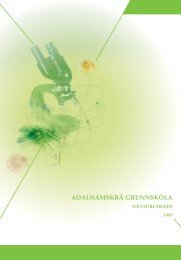
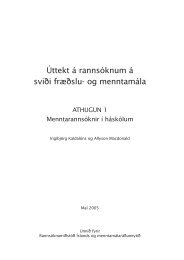

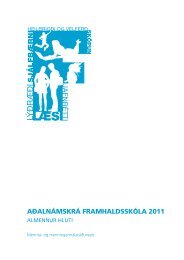
![Aðalnámskrá tónlistarskóla : rytmÃsk tónlist [Eingöngu á rafrænu formi]](https://img.yumpu.com/50843672/1/184x260/aaalnamskra-tanlistarskala-rytma-sk-tanlist-eingangu-a-rafranu-formi.jpg?quality=85)
